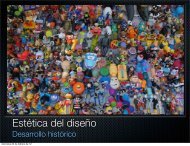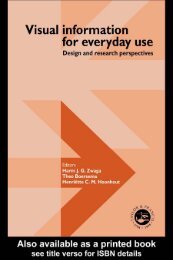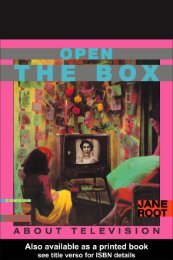Edited by Chris Jenks - carlosmoreno.info
Edited by Chris Jenks - carlosmoreno.info
Edited by Chris Jenks - carlosmoreno.info
You also want an ePaper? Increase the reach of your titles
YUMPU automatically turns print PDFs into web optimized ePapers that Google loves.
AN INTRODUCTION<br />
etymology of the word ‘advertising’, charting its development from the<br />
original and supposedly innocent sense of ‘<strong>info</strong>rming’ up to the more<br />
suspicious and potentially reprehensible sense that it has acquired through<br />
modernity of ‘persuading’ and ‘influencing’. Barnard’s analysis constitutes<br />
a deconstruction of this development and the conceptual gap that it has<br />
enabled. He argues that the supposedly innocent sense has never and can<br />
never have existed apart from the sense of influencing. Such reasoning has<br />
a significant impact on the ideas contained within certain canonical texts on<br />
advertising, such as those of Raymond Williams and Judith Williamson,<br />
which still appear to imply that a more innocent form of advertising is both<br />
desirable and possible. Barnard draws out the implications of this debate for<br />
advertising in general, but most particularly for cigarette advertising where<br />
the issues of innocence and persuasion are most sharply and poignantly felt,<br />
interwoven with issues of morality, health and ecology, and political<br />
economy.<br />
Foucault <strong>info</strong>rmed us that the origins of modern sociology are not to be<br />
found in the works of Comte or Montesquieu but rather in the mundane<br />
practices of doctors. Early nineteenth-century doctors were ‘specialists in<br />
space’. They practised in the enclosed spaces of hospitals, medical schools<br />
and operating theatres but also in the open spaces of cities and towns. And<br />
they raised questions not just about the health and pathology of the<br />
individual body, but about the environment of the collective body; the<br />
quality of hygiene and climate, the density of habitation and the rate of<br />
migration of peoples and diseases—in short, the social context. From this<br />
inspiration Andrew Barry sets out on an analysis of the practices of<br />
visualising and reporting.<br />
Barry suggests in his chapter that the translation of the doctor’s expertise<br />
from the hospital and the bedside to the city is, perhaps, one symptom of<br />
a more general historical phenomenon. As a number of writers have noted<br />
the nineteenth century saw a vast increase in efforts to observe and document<br />
the wider social and natural environment, whether on the part of government<br />
inspectors, statisticians, political economists, sociologists, botanists,<br />
geologists or hygenists. While the technical and social apparatus of<br />
experimental science developed rapidly in the nineteenth century, so also did<br />
a range of disciplines concerned with the observation of social, biological<br />
and physical phenomena as they ‘naturally’ occurred. The typical scientific<br />
observer of the nineteenth century was to be found, then, as much outside<br />
as inside the artificial space of the laboratory.<br />
In discussing the development and consequences of ways of knowing<br />
distant events many contemporary writers, such as Jay and Giddens, have<br />
drawn upon Foucault and in particular his ideas on surveillance. Thus the<br />
extended territory of the nation or the empire is conceived of as<br />
‘panoptical-instrumental space’ ruled through techniques of surveillance.<br />
In this chapter Barry questions whether modern techniques for<br />
17






